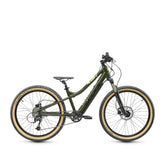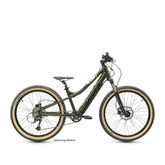How do you recognize a good children's bike?
Challenge of buying a children's bike.
If you ask the youngsters what the new two-wheeler should look like, the main focus is probably on a cool look. This is - without a doubt - extremely important, but in addition to the aesthetic aspects, there are other criteria that you should keep in mind when choosing a new fleet member. What should you pay attention to when buying a bike? How do you recognize a good bike for children? What is out of the question?
We reveal which bike features are important for the youngest and which are not.
The right size
It sounds strange, but it's true: One of the most crucial features when buying a good bike for your child is choosing the right size. This should harmonize with the child's height or inner leg length and match their motor skills. A size table can provide assistance, but we always recommend a personal trial session. You can find a size table here:
Image/Size Chart
However, the age of the child alone should not be taken into account. The individual differences from child to child are too great to be able to make general statements here. A 6-year-old who should theoretically ride an 18-inch bike might need a 16-inch bike, while a tall 5-year-old feels perfectly comfortable on a 20-inch bike.
You should also stay away from the theory that you hear again and again: “It’s better to go a size larger – then it will last longer!” So that your child can move around well and, above all, safely on their bike, they need a two-wheeler that fits now - and not in a year.
Note from our own experience: If the children's bike is too big, the children have difficulty holding it, stopping it and even learning to ride it becomes difficult. And when children don't enjoy something, they often lose interest completely. Re-entry will then be even more difficult.
The right weight
When it comes to bike weight for children, the lighter the better!
The reason for this is best explained using a simple calculation example:
While the weight of a normal adult bike is usually around 20 percent of their body weight, this value can be between 40 and 80 percent for a child or teenager, depending on the bike model. The less weight your child has to struggle with on their bike, the more fun they will have while riding. Be it when tackling inclines and hills, making turning maneuvers or carrying things up stairs. A light bike is much easier to handle - and therefore much safer. For this reason, the weight of all models of our ACADEMY bikes is 40 percent less than that of an average child. But the S'COOL SL series also has a lot to offer here.
The right equipment
If the bike is to be used to go to school or for bike tours with the family, it should have road-safe equipment in accordance with the StVZO. This is standard equipment on most bicycles. This includes two independently acting brakes, a bell, lighting and reflectors.
The correct bottom bracket height and crank length
When choosing a new children's bike, pay attention to child-friendly bottom brackets. These should be narrow and low so that they are optimally tailored to the ergonomic requirements of children and young people. Short pedal cranks and an upright sitting position ensure an ergonomic knee position while riding and at the same time ensure that the young riders ' feet can reach the ground at all times.
Training wheels – yes or no?
If the two-wheeler is a bike for beginners , the question might arise as to whether training wheels could be interesting. We would advise against this. In fact, training wheels actually delay the learning process because they give the child a completely false sense of balance. It is not uncommon for a new biker to have to start from scratch when removing the training wheels. Our recommendation is therefore to avoid training wheels and instead use a balance bike before your first bike. This can provide good preparatory work to make it easier for your child to get started on their cycling career, as essential factors for cycling, such as balance, motor skills and coordination, are trained in a playful way.
Our conclusion
In order to find the right children's bike for your child, you should always pay attention to the right size that harmonizes with the child's height and motor skills. In addition, children benefit from lightweight bicycles that make handling easier and ensure greater safety on the road.
Speaking of road traffic: If the child uses their bike to go to school or kindergarten, equipment in accordance with the StVZO is mandatory. Furthermore, attention should be paid to an ergonomic knee position, bottom bracket height and crank length.




